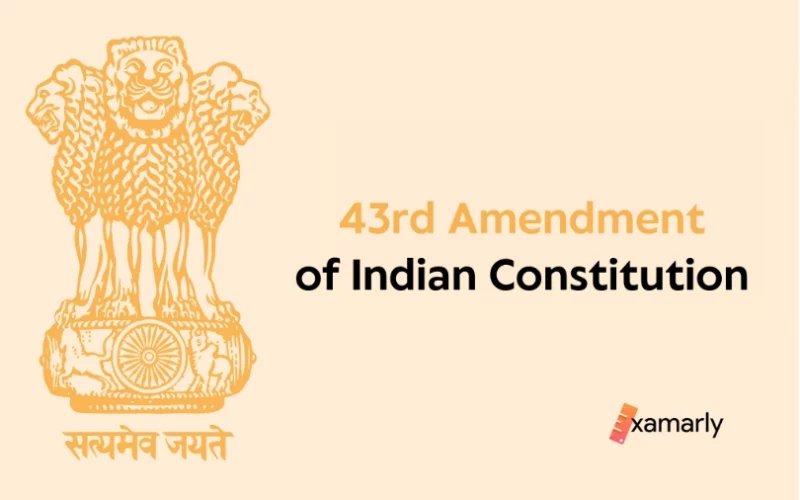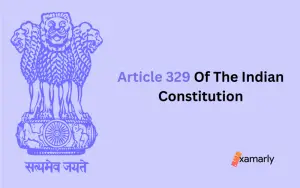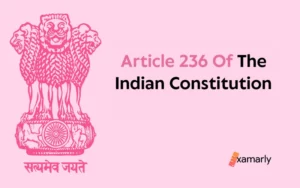The 43rd Amendment of the Constitution of India is officially known as the Constitution (Forty-third Amendment) Act, 1977. This Act repealed the six articles that the 42nd Amendment had introduced to the Constitution.
The Indian National Congress, under the direction of Indira Gandhi, had passed these articles during the Emergency. It was passed by the newly elected Janata Party. The party had won the general elections in 1977 by promising to “restore the Constitution to the condition it was in before the Emergency”.
Read this to get in-depth knowledge about the 43rd Amendment of the Indian constitution.
- 43rd Amendment of Indian Constitution
- Key Points about the 43rd Amendment of Indian Constitution
- Proposal and Enactment
- Constitutional Changes
- Statements of Objects and Reasons
- Key Features of the 43rd Amendment of Indian Constitution
- 10 Major Provisions of the 43rd Amendment
- 1. Omission of Article 31(D)
- 2. Omission of Article 32(A)
- 3. Omission of Article 131(A)
- 4. Omission of Article 144(A)
- 5. Amendment of Article 145
- 6. Amendment of Article 226
- 7. Omission of Article 226(A)
- 8. Amendment of Article 228
- 9. Omission of Article 228(A)
- 10. Amendment of Article 336
- Ratification
- Summary
- FAQs around the 43rd Amendment of Indian Constitution
- When was the 42nd Amendment of the Indian Constitution passed?
- What were the major changes brought about by the 42nd Amendment?
- Have any amendments been made to the Indian Constitution to undo the changes brought about by the 42nd Amendment?
- When was the 44th Amendment of the Indian Constitution passed?
- Why was the 44th Amendment of the Indian Constitution necessary?
- Was the 44th Amendment controversial?
43rd Amendment of Indian Constitution
On April 13, 1978, the President of India approved the 43rd Amendment. The Janata government passed it. This was carried out to undo the distortions brought about by the 42nd Amendment Act of 1976.
The following articles were modified by this act:-
- Article 145,
- Article 226,
- Article 228, and
- Article 366.
Whereas the following articles were removed by:-
- Article 31(D),
- Article 32(A),
- Article 131(A),
- Article 144(A),
- Article 226(A), and
- Article 228(A).
Key Points about the 43rd Amendment of Indian Constitution
- This Act nullifies the terrible 42nd Amendment fundamental rights law that was passed during the Emergency. By eliminating Article 31D, it restores civil liberties. Under the cover of anti-national activity prevention legislation, this gave Parliament of India the authority to restrict even legal union activity.
- Under the Constitution, the new law has been approved by more than half of the States. Additionally, this restores legislative powers for the states that adequately address anti-national activity while upholding fundamental rights. The judiciary was likewise put back in its proper place by the legislation.
- Now that the 42nd Act has been repealed, the Supreme Court will have the authority & jurisdiction in respect to declaring state laws unlawful.
Also read: Important Amendments of Indian Constitution.
Proposal and Enactment
On December 16, 1977, the Constitution (Forty-third Amendment) Act of 1977 was introduced in the Lok Sabha. It was first introduced as the Constitution (Forty-fourth Amendment) Bill, 1977. Shanti Bhushan, Minister of Law, Justice, and Company Affairs introduced it. Articles 145, 228, and 366 were the targets of the bill. Furthermore, it does not include the Constitution’s Articles 226(A), 228(A), 131(A), 32(A), 144(A), or 31(D).
The Lok Sabha discussed the bill on December 19 and 20. Later, on December 20, the Bill was passed when a formal constitutional change was adopted to change the word “forty-fourth” to “forty-third” in Clause 1. Clauses 7 to 10 of the bill got updated as Clauses 8 to 11.
The Rajya Sabha later approved it on December 23, 1977.
Important from the UPSC point-of-view: Amendment Procedure of Indian Constitution.
Constitutional Changes
The following is a brief on the constitutional changes that the 43rd Amendment of Indian Constitution brought with it:-
- Six articles that had been added to the Constitution by the 42nd Amendment were removed by the 43rd Amendment. Articles 31(D), 32(A), 131(A), 144(A), 226(A), and 228(A) fall within this category. In order to get rid of these six articles, Articles 145, 228, and 366 have to be changed.
- Legislation about “anti-national actions” and “anti-national associations” was made possible by Article 31(D).
- Article 32(A) of the Constitution said that the Supreme Court would not look at the constitutionality of state laws during writ proceedings to enforce Fundamental Rights. The said article has been omitted.
- A similar ban on High Courts deliberating the constitutionality of Central laws was imposed by Article 226(A). The said article has been omitted.
- Section 4 omits article 131(A) relating to the exclusive jurisdiction of the Supreme Court in regard to questions as to the constitutional validity of Central laws.
- A Central or State law could only be declared unconstitutional by the Supreme Court under Article 144(A) with a bench of at least 7 justices. Moreover, a two-thirds special majority of the bench is required.
- Under Article 228(A), a High Court could only declare a State law invalid if the decision was made by a bench of at least five judges. Additionally, a special majority of two-thirds of the bench voted in favor of the motion.
You might also like to read about: Types of Amendments in Indian Constitution.
Statements of Objects and Reasons
During the discussion on the 43rd Amendment of Indian Constitution, the following statements of objects & reasons for it’s provisions were made:-
- Several new articles were added to the Constitution by the Constitution (Forty-second Amendment) Act of 1976. This was done to limit the Supreme Court’s and the High Court’s authority to examine the constitutionality of laws in both a direct and indirect manner.
- Article 32A forbade the Supreme Court from debating the constitutionality of any State law. This includes cases involving the enforcement of fundamental rights unless the constitutionality of any Central statute was also in dispute.
- According to Article 131A, the Supreme Court has sole authority to determine whether a Central statute is constitutional. The High Courts were thereby deprived of their authority over the matter.
- According to Article 144A, there must be a minimum of seven Supreme Court judges present while a Central law or a State law is being reviewed for constitutionality. Furthermore, a special majority of two-thirds was necessary for the statute to be declared illegal.
- The High Courts were not permitted to rule on the legality of any Central laws under Article 226A.
- A bench of at least five judges was necessary by Article 228A to decide whether any State statute was constitutional. This article also set forth a specific majority requirement for a judgment declaring such a statute unlawful.
- People who live in remote areas of India are said to experience suffering as a result of articles 32A, 131A, and 228A.
- Additionally, many proceedings would result from article 32A. Because the High Court must first examine issues involving the legality of State laws that could be decided by the Supreme Court itself. No matter how insignificant the challenge, the minimum number of judges in every case where the constitutionality of legislation is at issue wastes important judicial time by hearing and rejecting ineffective arguments.
- In M/s. Misrilal Jain v. the State of Orissa and Others (AIR 1977 SC 1686) the Supreme Court expressed the expectation that article 144A would prompt Parliament’s immediate response. Additionally, the law would be changed to provide the court the authority to choose the size of the bench that should hear a given case.
- As a matter of fact, many cases have been delayed in the High Courts and Supreme Court. This is because of the aforementioned articles.
- Articles 32A, 131A, 144A, 226A, and 228A are thus proposed to be deleted. Additionally, it is suggested that special provisions be made. This is done to allow the Supreme Court and the High Courts to handle pending cases in the same way as if the aforementioned articles had been deleted beginning on February 1st, 1977. (viz., the date on which those articles were brought into force).
- In addition to this, it is recommended that the articles 145, 228, and 366 all receive the appropriate consequential changes.
- The Parliament is given special power under Article 31D. These authorities are responsible for passing legislation pertaining to anti-national activities. The power of Parliament to enact laws to address anti-national conduct and anti-national groups is thought to be extremely broad. Moreover, have the potential for abuse. As a result, it is suggested that article 31D be removed.
Read Also: Amendment of Indian Constitution and Basic Structure Theory.
Key Features of the 43rd Amendment of Indian Constitution
| Who introduced it? | Shanti Bhushan, the Minister of Law, Justice, and Company Affairs. |
| When was it Introduced? | In the Lok Sabha on 16 December 1977. |
| The official name of the Constitutional Amendment: | The Constitution (Forty-third Amendment) Act, 1977. |
| Which articles were amended? | Articles 145, 228 and 366. |
| Which articles were omitted? | Articles 31D, 32A, 131A, 144A, 226A and 228A. |
Important for UPSC: Tricks to Remember Amendments of Indian Constitution.
10 Major Provisions of the 43rd Amendment
1. Omission of Article 31(D)
Article 31(D) of the Constitution empowering Parliament to make laws in respect of anti-national activities and anti-national associations has been omitted. (Section 2)
2. Omission of Article 32(A)
- Article 32A of the Constitution shall be omitted.
- Before the implementation of this Act, the Supreme Court may decide on any cases that were pending under article 32 of the Constitution before it. As if, as of and beginning on the first day of February 1977, said article 32(A) had not existed.
3. Omission of Article 131(A)
- Article 131(A) of the Constitution is going to be taken out of the Constitution altogether.
- Regardless of what is stated in Sub-Clause (1), the Supreme Court may, while taking into account-
- (a) the current stage at which the reference is still pending;
- (b) justice’s goals,
With effect on and from the first day of February 1977, either handle the matter as if that article had not been omitted or send the High Court’s case back for disposition as if it had been omitted.
Related Article: Advisory Jurisdiction of Supreme Court.
4. Omission of Article 144(A)
- The Constitution’s Article 144(A) shall be deleted.
- The Supreme Court may decide on any case that was pending before the passage of this Act. As if the aforementioned article 144(A) had been deleted as of the first day of February 1977.
5. Amendment of Article 145
According to the Constitution’s article 145,
- (a) The phrase “article 139(A)” shall be substituted for the words, figures, and letters “articles 131(A) and 139(A)” in Sub-Clause (cc) of Clause (1);
- (b) The words, figures, and letter “article 144(A) and of” shall be deleted from clause (2);
- (c) In clause (a), the phrases, numbers, and letter “Subject to the limits of Article 144(A)” must be removed from Clause(3).
You might also like to read about:
6. Amendment of Article 226
Clause(1) of article 226 of the Constitution shall remove “but subject to the restrictions of article 131(A) and article 226(A)”.
7. Omission of Article 226(A)
- The Constitution’s Article 226(A) shall be deleted.
- Before the implementation of this Act, the High Court may handle any cases that were pending before it under article 226 of the Constitution. As if the aforementioned article 226(A) had been deleted as of February 1st, 1977.
8. Amendment of Article 228
The phrase “, subject to the restrictions of article 131(A)” and its modifiers shall be removed from the first clause of article 228 of the Constitution.
9. Omission of Article 228(A)
- The Constitution’s Article 228(A) shall be deleted.
- Any case that was ongoing before a High Court at the time this Act was enacted may be handled by the High Court. As if the aforementioned article 228(A) had been deleted beginning on February 1st, 1977.
Also Read:
10. Amendment of Article 336
Clauses 4(A) and 26(A) of Article 366 of the Constitution must be deleted.
Ratification
In compliance with the Constitution’s Article 368 requirements, the Act was passed.
Additionally, as required by Clause (2) of the aforementioned article, it received the approval of more than half of the State Legislatures. Andhra Pradesh, Assam, Bihar, Gujarat, Haryana, Himachal Pradesh, and other state legislatures were among those to ratify the change.
The modification was not ratified by Kerala, Uttar Pradesh, Jammu and Kashmir, and Karnataka.
If you want to know more about the states & territory of India, read our blogs on:
Summary
The Janata government passed the Forty-Third Amendment Act of 1977. This was done to undo some distortions that the 42nd Amendment Act of 1976 had created.
The Supreme Court’s and the high court’s authority to issue writs and carry out judicial reviews was reinstated by the Act. Additionally, it deprived the Parliament of its unique power to enact legislation to address anti-national activity.
Read Also: Types of Writs in India.
FAQs around the 43rd Amendment of Indian Constitution
When was the 42nd Amendment of the Indian Constitution passed?
The 42nd Amendment of the Indian Constitution was passed on December 18, 1976.
What were the major changes brought about by the 42nd Amendment?
The 42nd Amendment brought about several changes to the Indian Constitution. Some of the major changes included:
1) It inserted the words “socialist” and “secular” into the Preamble of the Constitution.
2) It made the Fundamental Duties of citizens enforceable by law.
3) It curtailed the power of the judiciary to review constitutional amendments.
4) It gave the Parliament unlimited power to amend the Constitution.
Have any amendments been made to the Indian Constitution to undo the changes brought about by the 42nd Amendment?
Yes, several amendments have been made to the Indian Constitution to undo some of the changes brought about by the 42nd Amendment. The 44th Amendment of the Indian Constitution, passed in 1978, restored some of the fundamental rights that had been taken away by the 42nd Amendment and curtailed the power of the Parliament to amend the Constitution. Other amendments have also been made to restore the balance of power between the legislature, judiciary, and executive.
When was the 44th Amendment of the Indian Constitution passed?
The 44th Amendment of the Indian Constitution was passed on April 30, 1978.
Why was the 44th Amendment of the Indian Constitution necessary?
The 44th Amendment was necessary to restore some of the fundamental rights that had been taken away by the previous amendments, particularly the 42nd Amendment. The 42nd Amendment had given the Parliament unlimited power to amend the Constitution and had curtailed several fundamental rights. The 44th Amendment was seen as a way to restore the balance of power between the legislature, judiciary, and executive and to protect the fundamental rights of the citizens.
Was the 44th Amendment controversial?
The 44th Amendment was not particularly controversial and was supported by most political parties at the time. However, some people criticized the amendment for not going far enough in restoring some of the fundamental rights that had been taken away by the 42nd Amendment.






